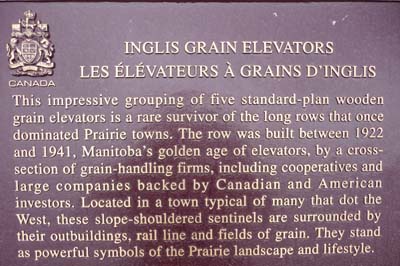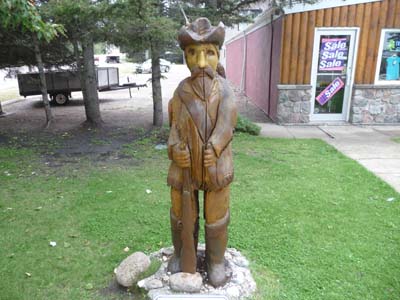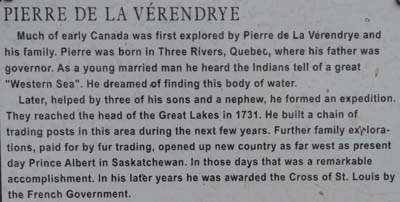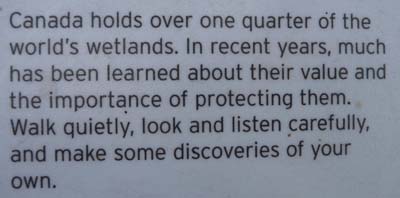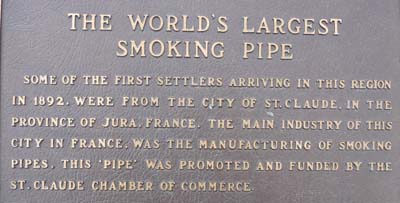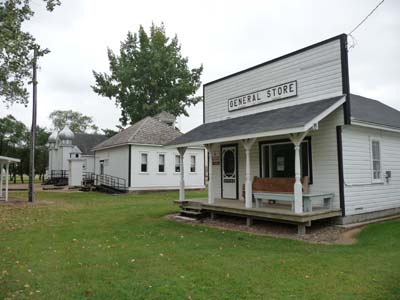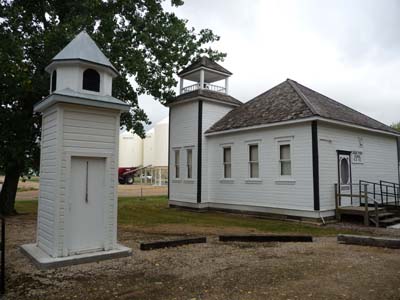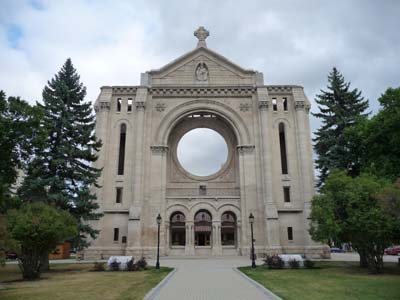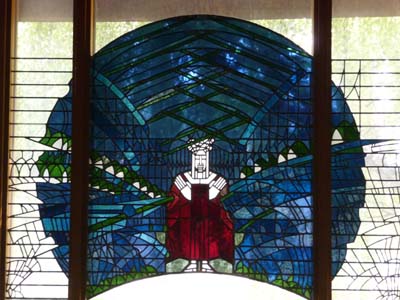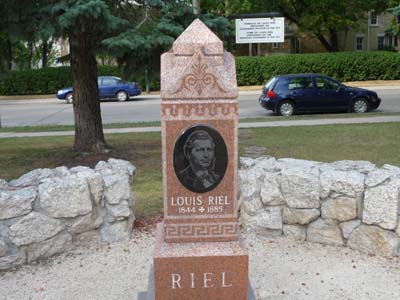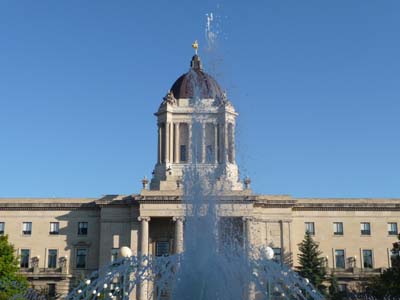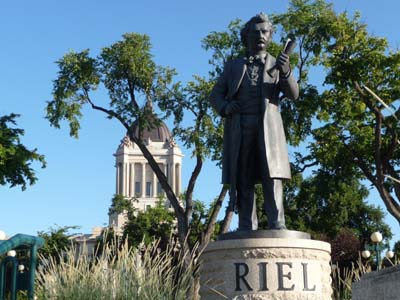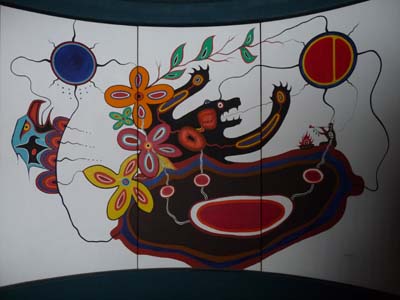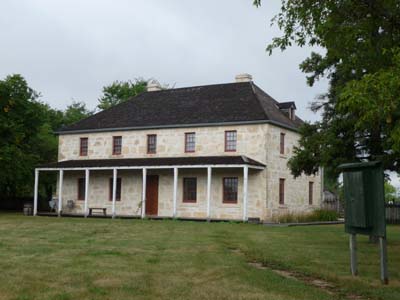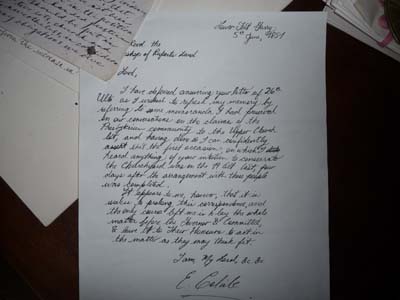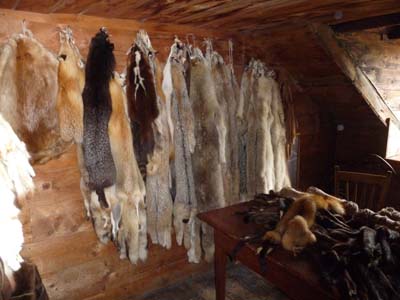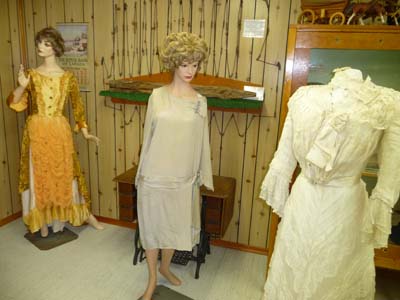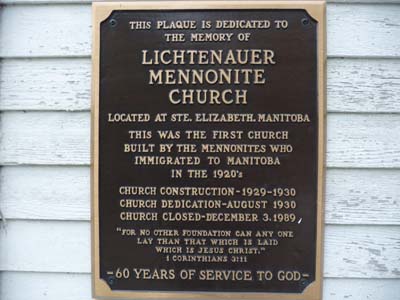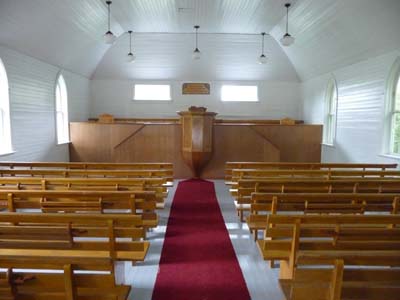-- From Yorkton to Steinbach

The road tracklog
from
Yorkton to Steinbach
from 2011/08/29 to 2011/09/04
Manitoba
Manitoba was at the beginning of the 19th century called the Northwest Territories then they were divided into two, Manitoba and Saskatchewan, two cereal provinces. Both have a surface about equal to that of France but with a much lower population because north is very little populated. The capital is Winnipeg with a population of +600,000 inhabitants more half of Manitoba.
Russell
The border town on Hwy #16 is Russell where I made my usual harvest of booklets in Visitor Center.
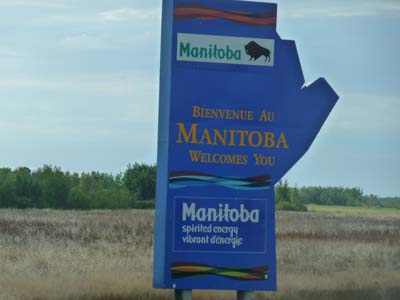
Manitoba, MB
Hwy #45
29/08/2011

Visitor Centre
Russell
29/08/2011
Inglis
At the beginning of afternoon I visited Inglis which preserved five grain elevators built at the end of the 19th century and in use until WWII. They are intended to be a historic site after restoration and installation.

|
|
I decided to spend the remainder of the day at Russell Reservoir to prepare my trip in Manitoba by exploiting tourist booklets. The weather was gloomy with heavy showers.
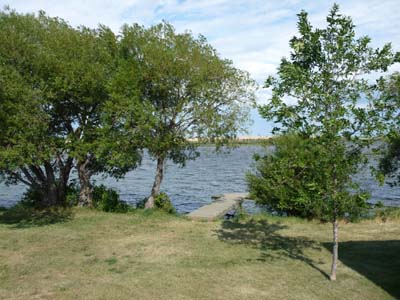
Russell Reservoir
Hwy #83
29/08/2011
Riding Mountain National Park
The day was gloomy and cold. In Riding Mountain NP few tourists were in the streets and at the edge of Clear Lake. I went to Visitor Center housed in a splendid log house of the Thirties, inside the stuffed animals made tapestry. I wandered in the streets and on the edge of the lake without goal, I took some pictures randomly. The season touched at its end, I decided to leave southwards the province.
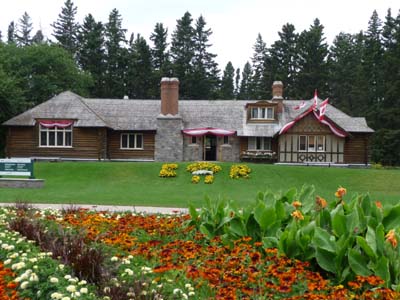
Visitor Centre
Riding Mountain NP
30/08/2011
|
|
|
|
On the way I stopped to look at a type Manitoba's farm, on the left the modern buildings of dwelling, a traditional red barn and grain silos in great number.
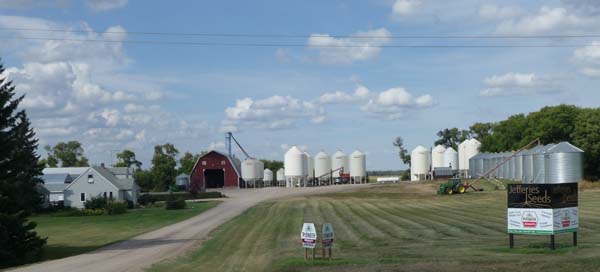
On Hwy # 2 I found a bivouac at the Wetland Cypress which invited the tourist to walk on a boardwalk by reading the interpretive signs.
|
|

Discover French-speaking Manitoba's
Joie de vivre!
Mostly across the south of the province
Among the collected booklets at Russell there was one of them inviting to visit the bilingual cities offering an incomparable French way of life. The list included some nearly a score, I made a selection. I coasted in the cereal fields on grid roads. Unfortunately in some cities either there was no Visitor Center or the museum was closed!

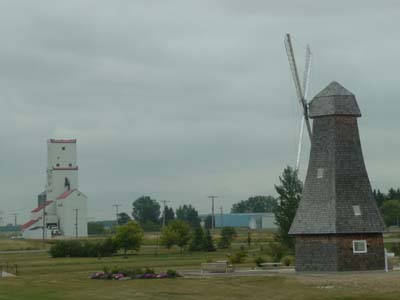
Elevator & Windmill
Holland
31/08/2011
St Leon
In St Leon the Interpretive Centre on wind energy informed me on this source of energy little developed in France. Interpretive signs explained why the harmful effects were controlled since many years in particular by the Danish precursory of this technology.
|
|
St Claude
in St Claude I was accommodated by an huge smoking pipe symbol of the origin of the name of the city which has a remarkable dairy museum.
|
|
|
|
Bazinb Family
By arriving on the site of the museum my computer in the cabin detected WiFi Internet connections of which one bore the name of Bazin, but I do not have a WiFi modem. Obviously there was in this city someone named Bazin. At the old station beside the museum I presented myself at the hostess by asking whether there were a Bazin family. The answer was positive and I counted 10 Bazin names in the telephone directory. Little time after several people arrived including three ladies born Bazin. I learned that the senior of the family, Lucienne, lived the city. I announced myself by telephone, she accepted me and I spent a long moment listening to the genealogy of the Bazin Family in Canada. Her Pierre grandfather, born in 1870 arrived in Canada in 1891. He made his family come, his father Joseph-Alexandre, his two brothers Jean-Marie and Eugene as well as his sisters. The three young men had 17 boys who ensured the perennially of the name. The brother of Lucienne, Roger, currently travels from there in France. The French cradle of the family is in St James, Île et Vilaine, Bretagne. I left St Claude amazed by this fortuitous discovery and the marvelous moments spent to listen Lucienne. I carried on my road towards Carman, Morden and Winkler where I stationed in Walmart.
|
|
St Joseph
The following day on the way for Winnipeg I was not luckier because in this first day of September the tourist season was finished and some museums were closed. At St Joseph I wandered on the site as a heart pains when a man bu bicycle came to my prevented by two young ladies from whom I had requested the direction for the museum. He informed me that the student in charge of the visit had completed his voluntary job. The visit will be made by the senior of the village. The museum is a village in the village, houses were moved and installed with their furniture of origin. Moreover one building houses furniture of time given by French-speaking villagers of the villages of the vicinity. The comments of my guide were an enchantment concerning the roots of the various families, Delorme, Sarassin and some others.

Mon guide
St Joseph
01/09/2011
|
|
|
|
St Pierre Jolys
At St Pierre Jolys the museum of the convent of the Sisters of the Holy Names of Jesus and Mary was closed until next June.
|
|
Winnipeg, St Boniface
I arrived in the middle afternoon at Winnipeg and I failed at St Boniface the French district. Cathedral's St Boniface was destroyed by a fire in 1968, it remains only the walls. The bishop refused its rebuilding with the reason that the expenditure was ill-considered due to the needy ones in the world. A modern church was built inside the walls.
|
|
Beside the convent of the Grey Nuns, a oak-log building, is a museum focused on the emergence of the nation and the power of Métis at the time of the fur trade. It is especially dedicated to Louis Riel and the rising of the Métis, to see Batoche, and the execution of Louis Riel after a sham trial. In March 1992 the House of Commons of Canada recognizes Riel's “unique and historic role as a founder of Manitoba and his contribution in the development of Confederation.” Its tomb is in the cemetery in front of the Cathedral St Boniface. I bivouacked beside the Cathedral.
|
|
Winnipeg, Downtown
I devoted Friday September 02 to visit the downtown of Winnipeg by bicycle by a sunny but mild day. Museums open at 10 a.m. I strolled in the streets to discover the city, certainly it is a North-American city out of grid. Old buildings are rather rare. Manitoba Legislative Building is of classical architecture with a dome surmounting a pilaster, but the attraction is the statue of Louis Riel at the edge of Assiniboine River knowing that the frontage on Broadway Bld is preceded by a statue of Queen Victoria holding a scepter and a globe! During my peregrinations I noticed murals of which one is strange and incomprehensible for me.

Skyline
Winnipeg
02/09/2011
|
|
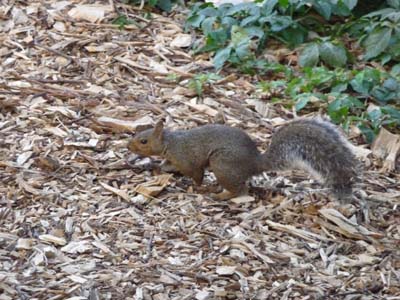
Squirrel
Winnipeg
02/09/2011
|
|
The Manitoba Museum
I visited two museums. The Manitoba Museum is since I am in Canada the most complete of the visited museums. Scenography is remarkable, the visit is a trip arrow with arrows on the ground to follow the didactic progression. It is impossible to report the collections. The first picture is the voyage of the Nonsuch which landed at Hudson Bay and was at the origin of the creation of the eponym company. The second shows Inuit clothing, indeed the collections of Inuit artifacts are very important. Finally the last is a reproduction of a view of the world by Cree people.
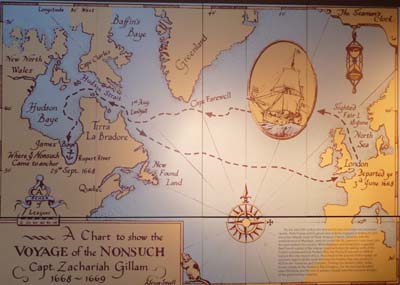
Map of the voyage of the Nonsuch
Winnipeg
02/09/2011
|
|
Winnipeg Art Gallery, Wag
My second visit in the afternoon was at Winnipeg Art Galery which exhibits sculptures and paintings by the local artists. I discovered a Cranach the Elder, an Utrillo, a Corot and a Chagall, alas no photo, ouch. A room is devoted to Carl Bean very famous Manitoban painter.

Coota Ashona, The Story of Nuliajuk 2009
Winnipeg
02/09/2011
|
|
Gabrielle-Roy House
The day was completed at the Gabrielle-Roy House, famous Manitoban French-speaking author who accepted the French Femina award. In the early morning I had moved my truck to put it in the La Vérendrye St where I remained for the night.
|
|
The tourist season was really finished. I had made the dead end of the visit of the Riel House at the entry in Winnipeg, but considering the exhibits of the museum of the Grey Nuns I decided the outward journey to see it. Alas it was closed as the Presbytery and the Anglican Church of St Andrew's which was the heart of the religious life of the red river settlement, the buildings were built in 1830 out of limestone.

Riel House
Winnipeg
03/09/2011
St Andrew's
|
|
Lower Fort Garry
I have a little more chance in Lower Fort Garry of which it was before last day of opening but a violent rain curtailed my visit as well as animations in costumes of time. It was the only stone Fort built in 1830 by Hudson Bay Company –HBC–. The Treaty N°1 was signed in 1871 at the Fort with the First Nations, there were 11 treaties signed between the Crown of England and the First Nations. It was in activity until 1911. In 1951 Canada bought it at HBC and restored it as a national historic site.

HBC Flag
Lower Fort Garry
03/09/2011
|
|
The Big House is the main building where the business executives of the company placed. Furniture testifies to its splendor. In the courtyard buildings are warehouses where agents worked to the routing of goods and the preparation of furs.

The big House
Lower Fort Garry
03/09/2011
|
|
|
|
St Georges
The last visit was at the museum of St Georges which did not leave me an imperishable memory.
|
|
At the rest area at the edge of Winnipeg River I became acquainted with a French-speaking Manitoban . I decided to bivouac on the spot.

Winnipeg River
St Georges
03/09/2011
Steinbach
Mennonite Heritage Village
Before leaving Manitoba I visited Steinbach where a museum is made up of moved houses of the Mennonite community. At the 16th century at the time of the Reform in Europe a minority of Christians in Switzerland considered that the Church did not correspond to God's standards and the needs of people. These people wished a Church that was not controlled by the State as to have a community by which they adhered by the baptismal by mature adults. Moreover this community was against violence. With the origin they were called Anabaptists because they had been baptized as child they were re-baptized as adult. Persecuted they fled in Holland where Menno Simmons became the most important character of the community in 1536. The majority of Mennonites in Manitoba come from the south of Russia in 1874-80. Currently they are farmers, businessmen, teachers, doctors, lawyers etc The season was finished at the end of August, no animation in the village which seemed like dead in this cold Sunday on September. I attended the traditional ceremony of Mennonites with songs at Jesus' glory but without liturgy.
|
|

Church
Steinbach
04/09/2011
|
|
I found a RV-campground at the entry of the city. The following day I entered Ontario with a long road to go to Toronto, about 1,400 km.

